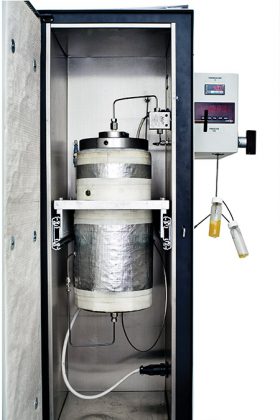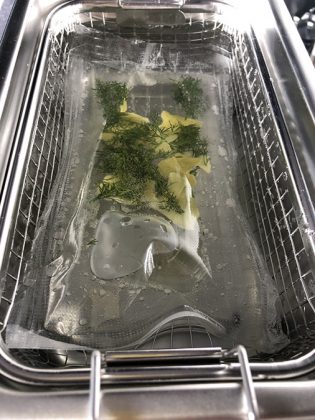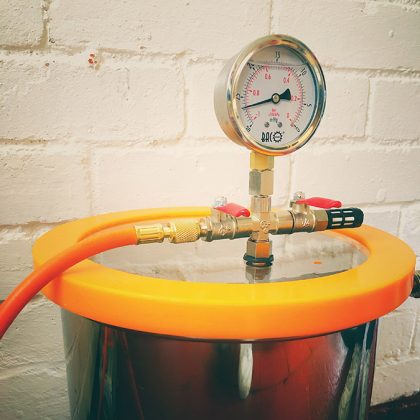Flavor, the ultimate frontier; everything we do comes down to flavor. Flavor extraction is an important part of making a spirit and makes up a large part of the drinking experience. So, what’s new in the world of flavor? How are people upping their game? What’s happening on the frontier? That wilderness at the edge of a town, not yet explored. Deriving from “the front line of an army,” a frontier can be thought of as an offensive line in a battle — always pushing forward, trying to conquer new territory. You could say that the force behind most human endeavour can be found on this precipice.
One of the things I love about the spirits industry is its constantly changing state. Much like liquid in a still, there is continual change and development. All those bubbles of experimentation colliding and creating ideas. All the vapor cooling into new things. It is an industry driven by innovation and creativity and there are wonderful things happening. Today, I’m catching up with some of the latest innovations in flavor extraction.
Before we go further, it’s worth noting the differences in flavor in spirits produced by the differing temperatures in pot stills and vacuum stills. It is a comparison often made in articles, that the heat involved in distilling through pot stills means the botanicals are cooked. And this comes across in the spirit, with deep, stewed flavors. Vacuum or cold distillation is used for more delicate, gentle botanicals that can be compromised under the temperature of pot distilling, and it yields brighter, fresher flavors. During vacuum distilling, a partial vacuum is created and the pressure reduced. This means that the molecules are not so tightly held together and the result is that they are easier to pull apart. Therefore, they can be distilled at a lower temperature, resulting in fresher, more delicate flavors (often compared to fresh fruit and jam).
At Hepple Spirits, distiller Chris Garden uses a mixture of these distillates, then H2O and Co. adds a marvelous little liquid called “the absolute of juniper” which they obtain through supercritical CO2 extraction, or SC-CO2 for short.
So, how does SC-CO2 work? Essentially, this technique means we can extract flavor with CO2 as opposed to a solvent. First, we need to understand the science of what makes something supercritical. What is a supercritical state, and how does that allow us to extract flavor? Well, everything has a supercritical state, and to get the CO2 to a supercritical state you have to exceed both the critical pressure and temperature of CO2. The critical temperature is the temperature where the CO2 cannot be liquified any more despite the pressure. The critical pressure is the pressure point at which gas is liquified. If you heat/pressurize the CO2 simultaneously to the respective critical points, the CO2 becomes both liquid and a gas. This state is great for flavor extraction. As a gas, the CO2 can reach small spaces and, like a liquid, it can dissolve to act like a liquid solvent. It’s in this state the flavor is extracted from the botanical — in Hepple’s case, juniper. Ground juniper is added to the extraction vessel. Then supercritical CO2 is pumped in. Where it meets the botanical, it breaks the trichomes, allowing it to break down the plant material. A pressure-release valve then allows the material to move into another vessel where the temperature and pressure rate are adjusted, meaning molecules bond with the CO2. These critical points vary depending on what you’re using; with CO2, it’s around 40 °C/104 °F and 3,000 psi. It is the same pressure as 7,000 ft. below sea level. That’s pretty impressive! As you can imagine, a flavor extraction using this technique requires special equipment.
The two boxes placed at right angles that make up Hepple Spirit’s supercritical extraction equipment are rather unassuming from the outside. Opening the upright box reveals a vessel around the size of a forearm. The space inside is much smaller, due to the incredibly thick steel needed to contain the pressure. The lid alone weighs 30 pounds!
This technique has a marvelous effect, and Hepple Spirits has been careful to record their experiments through GC-MS analysis, that is, gas chromatography-mass spectrometry, a beneficial practice that exposes the science behind the taste. Seeing a visual element of the compounds extracted through each type of distillation is incredibly helpful, and it reveals some really interesting things. We know that the process of distillation can change the makeup of compounds and therefore the flavor, but it seems that the supercritical process extracts different compounds than other distillations. Pinene is a relatively dominant compound extracted during juniper from pot and vacuum distillation, and others are notable but none of them intense. However, with SC-CO2, we start seeing a lot of other compounds at intense levels, such as terpinene, cubebene and undecatriene.
It’s these compounds that make the “absolute of juniper’’ which is, in Chris Garden’s words, “the most like juniper anything can be.” The liquid is a fantastic mustard-yellow color, and it’s a precious substance, taking 800 g of juniper to make just 20 ml of liquid. The absolute of juniper is essentially a flavor, and a small amount is added to the vacuum distillate, which is then blended with the pot still distillate to create the complete gin.
And how much experimentation has Chris done? Some, though it’s risky business. In one instance, in extracting flavor from a mixed blend of Douglas fir needles, Chris attempted the extraction as 60 °C/140 °F and 6,000 psi. The resulting substance was more wax than liquid, which blocked the equipment. In the end Chris had to put the pressure up to the safety line, to 80,000–90,000 psi, “real bottom of the ocean stuff,” and busted a safety mechanism called a burst disk, in order to get the machine open. It does take a lot of experimenting to find the sweet spot of temperature/pressure for a botanical. He is considering other experiments, although he confesses that he is now in a good rhythm using the equipment for juniper, and he doesn’t really want to lose that.
Supercritical extraction is not a new technology as such, but Hepple is very much a pioneer of applying the technology in this way. A study on “Supercritical carbon dioxide extraction of wheat distiller’s dried grain with solubles” found that “SC-CO2 is a suitable process for extraction of fatty oils with an improved percentage of essential fatty acids such as omega-3-fatty acid and omega-6-fatty acid.” Now, I’m no scientist myself. However, I did dig up some research that suggests that “Fatty acid ethyl esters are the main components of rum aroma and play an important sensorial impact in these distilled alcoholic beverages.” This would suggest another element of what makes up that increased depth of flavor profile. There’s just much more going on when this technique is used.
Supercritical is not the only exciting technique being experimented with at Hepple. Chris has also been playing with ultrasonic extraction, along with fellow former Sipsmith employee, Ben Peel, who is currently working on his own project.
Ben has been working on his own company H2O and Co., and when we spoke he was on the cusp of launching his new gin, John Robert’s Botanic Request. It is likely they will be up and running by the time this article is published. Ben worked in innovation at Sipsmith and has been experimenting with both ultrasonic flavor extraction and vacuum-pressured maceration to create his new gin. Ben is big on the science of distilling.
Ultrasonic sound frequencies allow us to collect delicate flavors from a botanical, while leaving other flavors and plant material behind. Vacuum-pressured maceration technique collects oil and flavor from hardy botanicals. The vacuum pressure used is double that at the summit of Mount Everest. Recipes are split between delicate and hardier botanicals with the appropriate technique being used for each. This isn’t a new thing as such, it’s a process often used with vacuum distilling, to create a distillate from delicate botanicals and use pot stills for the hardier stuff and blend them afterwards to create a wider spectrum of flavor in the finished product.
Vacuum-pressured maceration is essentially a forced osmosis. Osmosis naturally occurs during maceration, when solvent molecules move from the botanical into the alcohol solution. Creating a vacuum changes the pressure within the sealed container, forcing air and gasses inside the alcohol’s and botanicals’ cell structure to the surface. The structure of the cell implodes as the air leaves it and this softens the botanical. Also, as the air leaves the cell the alcohol solution rushes in to take its place, which speeds up flavor extraction, drawing out flavors and oil, which bond with the surrounding alcohol. After 14–16 hours, pressure is dropped and the botanicals suck up that already flavor-rich surrounding alcohol. This process is great for hardier botanicals as it softens and breaks down the cell structure, allowing alcohol to work faster in bonding and extracting the flavor compounds ready for distillation. However, this process is not just about “bending time,” as Ben puts it; when the pressure is dropped and the alcohol solution is reabsorbed by the botanical, this is “leaving no stone unturned. For us, we believe it brings a more full-bodied flavor and mouthfeel to the spirit, a subtle complexity. We wanted a spirit that had that creamy, full-bodied mouthfeel, and we think this process helped us to get there. With botanicals like cardamom, star anise, cassia, etc. — these are great to help achieve that mouthfeel, then by using this process we are really dialing it up.”
In combining vacuum-pressured maceration with ultrasonic sound extraction, Ben feels he has created something different with his gin. Ultrasonic sound extraction is a technique that is growing in popularity. And, there is a good reason to use it. It benefits botanicals in a similar way to vacuum distillation. Ben extracts flavor for around one hour at 30 °C/86 °F. “The difference, for us,” Ben begins “is the difference between a cold brew and hot, extracted coffee. Cold brew is extracted with cold water, and in turn you get sweeter and less astringent bitterness as it is gently extracted, whereas heat is more aggressive. Too hot and too long equals bitterness and astringency, and same applies for tea. As the hot water is not only extracting the flavor but then also attacking the botanical or plants’ mass/pulp/matter. it’s harder to control.” So how does it work? Ultrasonic is the use of sound waves through the solution to create microscopic implosions removing compounds, oils and flavors from all the nooks and crannies of the botanicals.
The transducer on the machine converts electrical energy to ultrasonic energy. The transducer increases in size creating a high frequency compression in sound waves. As these waves continue the cavitation bubbles grow larger. They can’t retain their shape any longer, so they burst and move through the liquid. They impact the botanicals, causing agitation, and this extracts the flavor. These bubbles act as microscopic scrubbing brushes. The formation, growth and collapse of the bubbles is a process called ultrasonic cavitation, the same technology powering the body-slimming wands you may have seen on the internet of late. The imploding bubbles create high temperature and pressure in a tiny space, acting like a scrubbing brush which agitates compounds from the botanical. Due to the action being so miniscule, it is incredibly effective at extracting flavor without damaging the botanical.
So there we have it, the low down on three new and exciting techniques for flavor extraction. SC-CO2 works to extract previously unobtainable compounds. Vacuum-forced maceration results in a faster maceration and bolder flavor. Ultrasonic flavor extraction allows us to obtain more delicate notes. Learning about these new techniques has been both eye opening and exciting. There is still so much possibility of what they can achieve. Hepple’s GC-MS analysis has revealed many flavor compounds that have been missing from pot and vacuum distillation, and that is just with juniper! The thought of new flavors hiding quietly in traditional botanicals is a wonderful thing. And the development of different techniques to find them is a wonderful thing, too. Here’s to the frontier, where human endeavor is forever pushing those boundaries further, inch by inch to greater things.












